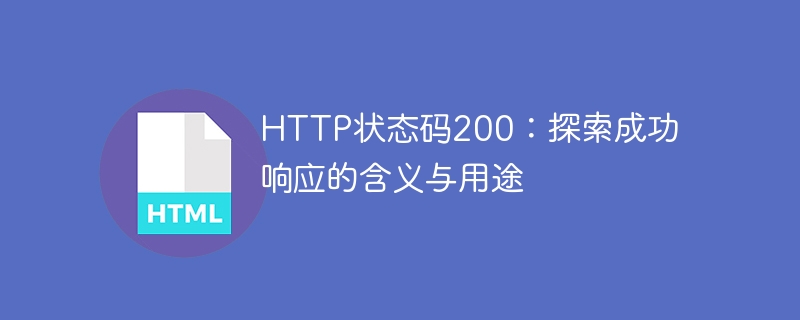Home >Web Front-end >HTML Tutorial >HTTP 200 OK: Understand the meaning and purpose of a successful response
HTTP 200 OK: Understand the meaning and purpose of a successful response
- WBOYWBOYWBOYWBOYWBOYWBOYWBOYWBOYWBOYWBOYWBOYWBOYWBOriginal
- 2023-12-26 10:25:221669browse

HTTP status code 200: Explore the meaning and purpose of successful response
HTTP status code is a numeric code used to indicate the status of the server's response. Among them, status code 200 indicates that the request has been successfully processed by the server. This article will explore the specific meaning and use of HTTP status code 200.
First, let us understand the classification of HTTP status codes. Status codes are divided into five categories, namely 1xx, 2xx, 3xx, 4xx and 5xx. Among them, 2xx indicates a successful response. And 200 is one of the most common status codes in 2xx.
The meaning of HTTP status code 200 is that the server successfully processed the client's request. This means that the server has responded normally and returned the requested resource to the client. Whether it is web browsing, file uploading, data transmission, etc., the server returns a 200 status code to indicate that the request is successful.
The 200 status code is very widely used. Whether it is a browser requesting a web page, a search engine crawling a web page, a mobile app requesting server data, etc., when the server successfully processes the request, it will return a 200 status code as a response. This status code allows the client to know that the request has been successfully processed and can continue with subsequent operations.
So, let’s take a look at some specific uses of the 200 status code in actual scenarios.
1. Web browsing
When we enter the URL in the browser and send a request to access the web page, if the server responds successfully and returns the web page content, the browser will display the page and return 200 status code. This means that we have successfully obtained the web page resources and the browser can present the content to the user normally.
2. File upload and download
When we upload a file to the server through a browser or other tool, if the server successfully receives the file and saves it in the specified location, the server returns 200 status code. When we download a file, if the server successfully sends the file to the client, it will also return a 200 status code. This means that the file upload or download process was successfully completed and the communication between the server and the client is normal.
3.API data interaction
In modern web applications, APIs are often used for data interaction. When the client requests data from the server through the API, if the server successfully processes the request and returns the required data, it will return a 200 status code. The client can determine whether the required data has been successfully obtained based on this status code, and perform corresponding operations.
To summarize, HTTP status code 200 represents a successful response. Whether it is web browsing, file uploading, data interaction, etc., if the server returns a 200 status code, it means that the request has been successfully processed and the corresponding resources can be accessed, downloaded, or used normally.
It is very important for developers to understand the meaning and purpose of status codes. By correctly handling the 200 status code, you can improve the user experience of your web application and make the entire system more stable and reliable.
Therefore, for the HTTP status code 200, we should fully understand its meaning and purpose, and effectively use this status code to ensure the successful processing of the request and provide a good user experience.
The above is the detailed content of HTTP 200 OK: Understand the meaning and purpose of a successful response. For more information, please follow other related articles on the PHP Chinese website!

